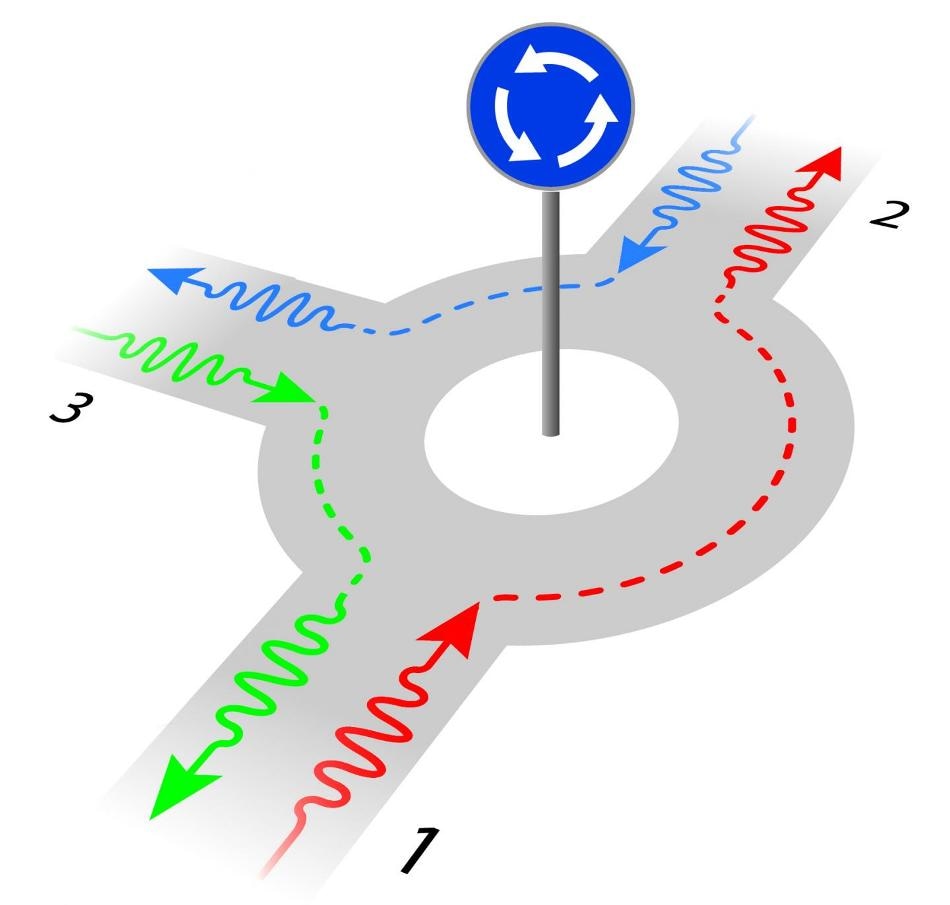Nov 15 2017
A team of researchers at IST Austria have created compact photon directional devices. Their micrometer-scale, nonmagnetic devices route microwave photons and can protect qubits from destructive noise.
 The new nonreciprocal device acts as a roundabout for photons. Here, arrows show the direction of photons propagation. (Credit: IST Austria/Birgit Rieger)
The new nonreciprocal device acts as a roundabout for photons. Here, arrows show the direction of photons propagation. (Credit: IST Austria/Birgit Rieger)
Qubits, or quantum bits, are the main building blocks that lie at the core of every quantum computer. So in order to perform a computation, signals have to be directed to and from qubits. At the same time, these qubits are very sensitive to disturbances from their environment, and need to be protected from undesirable signals, especially from magnetic fields. It is therefore a critical that the devices are constructed to shield qubits from undesirable signals, known as nonreciprocal devices, they themselves create magnetic fields. Furthermore, they are several centimeters in size, which is challenging, given that many such elements are needed in each quantum processor. Currently, researchers at the Institute of Science and Technology Austria (IST Austria), at the same time as competing groups in the United States and Switzerland, have reduced the size of nonreciprocal devices by two orders of magnitude. Their device, whose purpose they compare to that of a traffic roundabout for photons, is merely around a tenth of a millimeter in size, and—maybe even more notably—it is not magnetic. Their research paper was published in the open access journal Nature Communications.
When researchers want to get a signal, for example a microwave photon, from a qubit, but also prevent noise and other false signals from traveling back in the same route towards the qubit, they use nonreciprocal devices, such as circulators or isolators. These devices regulate the signal traffic, just like to the way traffic is controlled in real life. However in the case of a quantum computer, the traffic is photons in transmission lines not cars.
Imagine a roundabout in which you can only drive counterclockwise, at exit number one, at the bottom, there is our qubit. Its faint signal can go to exit number two at the top. But a signal coming in from exit number two cannot travel the same path back to the qubit. It is forced to travel in a counterclockwise manner, and before it reaches exit one, it encounters exit three. There, we block it and keep it from harming the qubit.
Dr. Shabir Barzanjeh, postdoc, IST Austria
The ‘roundabouts’ the team has built comprises of aluminum circuits on a silicon chip and they are the first to be based on micromechanical oscillators: Two small silicon beams oscillate on the chip similar to the strings of a guitar and interact with the electrical circuit. These devices are miniature in size—just about a tenth of a millimeter in diameter—, one of the main advantages the new component has over its traditional forerunners, which were a few centimeters wide.
At the moment only some qubits have been used to test the principles of quantum computers, but in the future, thousands or even millions of qubits will be linked together, and many of these qubits will need their individual circulator. “Imagine building a processor that has millions of such centimeter-size components. It would be enormous and impractical,” says Shabir Barzanjeh. “Using our nonmagnetic and very compact on-chip circulators instead makes life a lot easier.” Yet certain obstacles need to be overcome before the devices will be employed for this particular application. For instance, the available signal bandwidth at present is still quite small, and the necessary drive powers might damage the qubits. However, the researchers are assured that these issues can be solved.
Professor Johannes Fink joined IST Austria early 2016. He and his group study quantum physics in mechanical, electrical, and optical chip-based devices with the key objective of advancing and integrating quantum technology. At the beginning of this year, he received an esteemed ERC Starting Grant for his project to create a fiber optic transceiver for superconducting qubits, as well as a research grant from the Swiss NOMIS foundation. Dr. Shabir Barzanjeh was awarded a Marie Skłodowsa-Curie fellowship to work at IST Austria. His chief interests are in optomechanics and circuit quantum electrodynamics. From February 12 to 14, 2018, Johannes Fink und Shabir Barzanjeh will host the global conference “Frontiers of Circuit QED and Optomechanics” (FCQO 2018) in Klosterneuburg with the aim to unite leading scientists in the field.